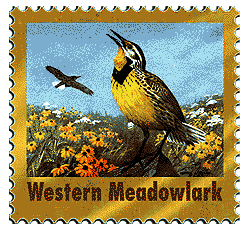
State Flower:
Wild Prairie Rose

State Bird:
Western Meadowlark

State Tree:
American Elm

State Flag:
The seal on North Dakota's flag resembles the Great Seal of the United States with the national bird, the bald eagle, holding an olive branch in its right claw and arrows in its left claw. The national motto "E Pluribus Unum" threads through its beak. Above its head are thirteen stars for the original thirteen states and on its breast is a shield of thirteen stripes. Above the seal is a rising sun shining its rays on a new nation, below the seal is the state name written on a red scroll.

Famous Person:
Sacajawea
"Capt. Clark arrived with the Interpreter Charbono, and the Indian woman, who proved to be a sister of the Chief Cameahwait, the meeting of those people was really affecting . . . "
-- Meriwether Lewis
Much is owed to Sacajawea (also spelled Sacagawea), the Shoshone women who aided Lewis and Clark in their exploration of the northwest territory. When she was only 12 years old, Sacajawea was captured by an enemy tribe and sold to a French Canadian fur trader, Toussaint Charbonneau. In 1805 Lewis and Clark hired Charbonneau as an Interpreter and allowed the sixteen-year old Sacajawea and her newborn son, Jean-Baptiste, to come along. It proved to be the best thing for the expedition since Sacajawea was a superior guide and better interpreter than Charbonneau. An extra bonus was that her presence also alleviated suspicions from other Indian tribes encountered on the thousand-mile journey. In fact, on August 17th of that year the expedition met up with a band of Shoshone led by Sacajawea's brother, Chief Cameahwait. The happy reunion between brother and sister was fortuitous for Lewis and Clark, as well, as the Chief supplied them with horses and guides, without which the exploration would surely have ended right then and there. Sacajawea's name is frequently mentioned in the diaries of both Lewis and Clark. Her support, determination and fortitude is legendary.